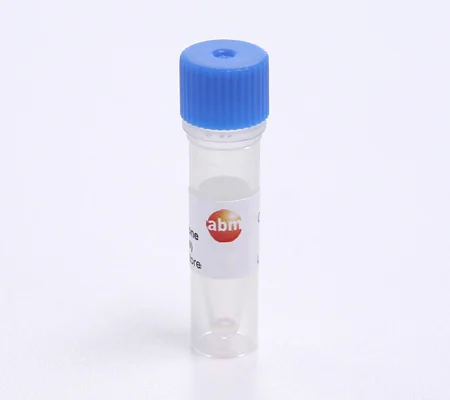
Lentifectin™ Transfection Reagent

| CAT.NO | UNIT |
|---|---|
| G074 | 1.0 ml |
| Description | Lentifectin™ is a transfection reagent specially formulated with multiple cationic polymers for the production of Lentiviral vectors in vitro. It is shown that Lentiviruses produced with Lentifectin™consistently have higher titers than those produced with Calcium-phosphate transfection or with other types of lipid transfection reagents |
|---|---|
| SKU | G074 |
| Applications | For production of high titer recombinant lentivirus plasmid in 293T cells. |
| Transfection Reagents Type | DNA Molecule |
| Caution | This product is distributed for laboratory research only. Caution: Not for diagnostic use . |
| Unit quantity | 1.0 ml |
| Storage Condition | Store at 4ºC. Do not freeze. |
Does freeze-thaw affect the performance of the transfection reagent?
Freeze-thaw does damage the transfection reagent slightly, at an approximate 5% loss. If possible, test the agent with a GFP control first.
Does the Lentifectin Transfection Reagent include packaging plasmids in addition to the cationic polymers?
No. The packaging plasmids are available separately. http://www.abmgood.com/Lentivirus-Packaging-Systems.html
Can this be used for both DNA and RNA transfection purposes?
Lentifectin will work for both DNA and RNA transfection. However we highly recommend using RNAfectin (Cat# G073) for RNA transfection in order to achieve optimal results.
Why do you need to add serum-free medium to the transfection complex as stated in step 4 of the protocol?
Transfection protocols often require serum-free conditions for optimal performance because serum can interfere with the transfection reagent. If you are looking for a reagent that is serum-compatible (in the presence of serum), you may use our DNAfectin Plus (Cat 2500) instead of Cat# G074.
What happens if solutions A and B are not incubated individually and instead mixed together right away?
The plasmids will still be packaged but the transduction efficiency may be affected.
The protocol provided in your datasheet also involves packaging. Which steps should I follow if I am interested in transfection only?
The protocol is provided so as to facilitate customers should you also wish to perform a packaging step. The Lentifectin™ Transfection Protocol may certainly be used as a guideline for transient transfection of your cell line with the plasmid of interest. We will specify the modifications that need to be made to this protocol, if packaging into lentivirus is not desired: For transfection of a plasmid into your cell line of interest, Steps 1 and 3a of our Lentifectin™ Transfection Protocol will be slightly different: Step 1: Instead of 293T cells, you will use your target cells Step 3a: Solution A will only include your expression vector, without any Packaging Mix, in serum-free, antibiotic-free medium.
- Ordelheide, A et al. "Nor-1, anovelincretin-responsiveregulatorof" Molecular Metabolism 2:243-255 (2013). DOI: 10.1016/j.molmet.2013.06.003. Application: Transfection.
- Wang, J et al. " CXCR6 Induces Prostate Cancer Progression by the AKT/Mammalian Target of Rapamycin Signaling Pathway" American Association for Cancer Research 68:10367-10377 (2008). DOI: 10.1158/0008-5472.CAN-08-2780. Application: Transfection.
- Wang, J et al. "Characterization of Phosphoglycerate Kinase-1 Expression of Stromal Cells Derived from Tumor Microenvironment in Prostate Cancer Progression" American Association for Cancer Research 70:471-480 (2010). DOI: 10.1158/0008-5472.CAN-09-2863. Application: Transfection.
- Kid, D et al. "Two non-coding RNAs, MicroRNA-101 and HOTTIP contribute cartilage integrity by epigenetic and homeotic regulation of integrin-α1" Cell. Signalling 25:2878-2887 (2878). DOI: 10.1016/j.cellsig.2013.08.034. Application: Transfection.
- Song, J et al. "MicroRNA-488 regulates zinc transporter SLC39A8/ZIP8 during pathogenesis of osteoarthritis" J. Biomed. Sci. 20 (31): (2013). DOI: 10.1186/1423-0127-20-31. Application: Transfection.
- Kim, D et al. "Peroxisomal dysfunction is associated with up-regulation of apoptotic cell death via miR-223 induction in knee osteoarthritis patients with type 2 diabetes mellitus" Bone 64C:124-131 (2014). DOI: 10.1016/j.bone.2014.04.001. PubMed: 24727161.
- Wang, J;Ying, G;Wang, J;Jung, Y;Lu, J;Zhu, J;Pienta, KJ;Taichman, RS;, et al. "Characterization of phosphoglycerate kinase-1 expression of stromal cells derived from tumor microenvironment in prostate cancer progression" Cancer Res. 70-2:471-80 (2010). PubMed: 20068185.
- Morgan, S. "PKA as the Effector of Beta-2-Adrenoreceptor Signaling Regulating Airway Smooth Muscle Relaxation" Thesis : (2013). Application: Transfection.
- Kim, D et al. "Two non-coding RNAs, MicroRNA-101 and HOTTIP contribute cartilage integrity by epigenetic and homeotic regulation of integrin-α1" Cell. Signal. 25:2878 - 87 (2013). DOI: 10.1016/j.cellsig.2013.08.034. PubMed: 24018042. Application: Transfection.
- George, R et al. "A SHORT INTERFERING RNA MOLECULAR BEACON FOR THE ATTENUATION OF MYCOBACTERIAL INFECTION" American Journal of Biochemistry and Biotechnology 10:40-49 (2014). DOI: 10.3844/ajbbsp.2014.40.49. Application: Transfection.
- Huang, J. et al. "Long non-coding RNA UCA1 promotes breast tumor growth by suppression of p27 (Kip1)" Cell Death Dis. 5(1):e1008 (2014). PubMed: 24457952.
- Song, J et al. "miR-370 and miR-373 regulate the pathogenesis of osteoarthritis by modulating one-carbon metabolism via SHMT-2 and MECP-2, respectively" Aging Cell 5:826-837 (2015). DOI: 10.1111/acel.12363.
- Song, J et al. "A long non-coding RNA, GAS5, plays a critical role in the regulation of miR-21 during osteoarthritis" J Orthop Res 32(12):1628-1635 (2015). DOI: 10.1002/jor.22718. PubMed: 25196583. Application: Gene Delivery, Lentivirus.
- Song, J et al. "PBMC and exosome-derived Hotair is a critical regulator and potent marker for rheumatoid arthritis" J. Clin. Exp. Med 15(1):121-126 (2015). DOI: 10.1007/s10238-013-0271-4. PubMed: 24722995. Application: Transfection, Gene Delivery.
- Song, J et al. "MicroRNA-222 regulates MMP-13 via targeting HDAC-4 during osteoarthritis pathogenesis" BBA Clin. :79-89 (2015). DOI: 10.1016/j.bbacli.2014.11.009.
- Kang, Y et al. "PCGEM1 stimulates proliferation of osteoarthritic synoviocytes by acting as a sponge for miR-770" J Orthop Res. : (2015). DOI: 10.1002/jor.23046.
- Geekiyanage, H et al. "MiR-31 and miR-128 regulates poliovirus receptor-related 4" Mol Oncol 9:1387-1403 (2016). DOI: 10.1016/j.molonc.2016.07.007. PubMed: PMC5100694.
- Geekiyanage, H et al. "MiR-31 and miR-128 regulates poliovirus receptor-related 4" Mol Oncol 9:1387-1403 (2016). DOI: 10.1016/j.molonc.2016.07.007.
- Li, Q., Chang, Y., Mu, L., & Song, Y. "MicroRNA‑9 enhances chemotherapy sensitivity of glioma to TMZ by suppressing TOPO II via the NF‑κB signaling pathway" Oncology Letters 17:4819-4826 (2019). DOI: 10.3892/ol.2019.10158.
- Von Dwingelo, J., Chung, I. Y. W., Price, C. T., Li, L., Jones, S., Cygler, M., & Abu Kwaik, Y. "Interaction of the Ankyrin H Core Effector of Legionella with the Host LARP7 Component of the 7SK snRNP Complex" mBio 10(4): (2019). DOI: 10.1128/mbio.01942-19.
- You, Z., Xu, J., Li, B., Ye, H., Chen, L., Liu, Y., & Xiong, X. "The mechanism ofATF3repression of epithelial-mesenchymal transition and suppression of cell viability in cholangiocarcinoma viap53signal pathway" Journal of Cellular and Molecular Medicine 23(3):2184–2193 (2019). DOI: 10.1111/jcmm.14132.


